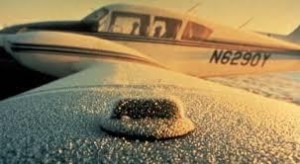Aircraft Deicing
By Michael FaginHistorical Weather Data, Weather Expert, Weather for PilotsWith 0 commentsAircraft Deicing techniques save them from a multitude of tragic fates. 9.5% of fatal aircraft crashes are due to icing. The leading edges of their wings, their tails and their noses ice over worst. Thick coatings add friction between the airstream and a wing’s airfoil, which can cause engines to stall below safe flying and pre-landing speeds. Another nightmare is when a large chunk of ice breaks off of a wing, flies into an engine and causes catastrophic failure.
A recent example of deadly aircraft icing was Continental Express Flight 3407, which crashed just outside Buffalo Niagara Airport on Feb. 12, 2009 due to wing icing. The foggy night delivered 17 mph winds and a wintry mix with intermittent light snow. A few miles short of the runway, Flight 3407 pitched and rolled before falling into a house in Clarence Center, NY, killing a man inside. Two escaped from the giant fire, which necessitated the evacuation of twelve neighbors. Onboard, 44 passengers, 4 crew and an off-duty pilot perished instantly.
The after assessment of the crash concluded that the deicing system turned off eleven minutes after takeoff from Newark Liberty International. The flight slowed to 145 KT before stalling. Failure of the wing flaps to properly flip up caused the stall. The propeller-driven Bombardier Dash 8 Q400 was put on autopilot, which is not recommended by the National Transportation Safety Board during icy conditions. The autopilot function hides – smooths over – subtle changes in an aircraft’s handling qualities, which can lead to stalling and a loss of control. It was deemed that properly triggered warning alarms weren’t properly heeded by the pilot. The fatal crash was the US’ first since Aug. 2006.
The formation of ice on aircraft is combated in several ways. The spraying of anti-ice fluids, mixtures of water and heated glycol, is the most common deicing technique while on the ground. Pilots disable ventilation systems while in-flight to ensure that fumes from the stinky but nontoxic liquids that are used then don’t enter the cabin. Ice and snow sensors outside of aircraft help them determine when to deice. Some aircraft recycle heated air from their engines onto their wings but this method creates unnecessary drag. Boeing 787s have liquid-metal “heating blankets” under their wings.
The leading tools to prevent critical ice buildup are deicing boots, invented by B. F. Goodrich in 1923. They are installed on the leading edges of wings and control stabilizers. The pneumatic systems fill boots with compressed air, which cause expansions that crack built up ice. The boots are ineffective against heavy icing and need to be replaced every three years, primarily due to punctures. [For more information about aircraft deicing, view the Aircraft Safety Advisor from the Air Safety Foundation.] In the instance of Flight 3407, the boots proved to be ineffective overall.
Current preventative techniques are very effective but there is still room for improvement. Better anti-ice liquid solutions will likely arise in the near future. A durable fuselage coating for aiding deicing is projected to arrive within the next fifteen years. New software is being used by Denver International that shaves off three minutes per flight by quickening deicing queues, a process that saves $88 million per winter. Due to the financial volume of the industry, new advancements may be worth fortunes for those who choose to make them happen.
Article written Meteorologist Geoff Linsley

